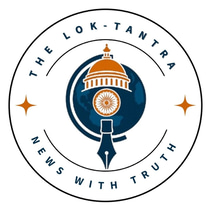The Assembly Elections in Jammu and Kashmir — A Historic Milestone
EDITORIAL
10/9/2024
The recently concluded assembly elections in Jammu and Kashmir marked a watershed moment in India’s political landscape, particularly due to the region’s complex history. These elections were the first since the abrogation of Article 370 in August 2019, a move that stripped Jammu and Kashmir of its special status and bifurcated it into two Union Territories — Jammu & Kashmir, and Ladakh. After a gap of several years, the restoration of democratic processes reflects a crucial moment in the central government's efforts to promote political stability, development, and reintegration of the region into the national mainstream.
The Background: A Return to Democracy
This election followed a period of political uncertainty that began in 2019 with the abrogation of Article 370. Jammu and Kashmir, now a Union Territory with reduced autonomy, was administered directly by the central government, leading to years of political vacuum and unrest. Calls for elections were a major demand, not only from political parties but also from citizens eager for representation. The elections signified a test of the region’s appetite for democracy after the seismic constitutional and political changes.
Political Players and Alliances
The electoral landscape in Jammu and Kashmir is shaped by a unique mixture of traditional regional powerhouses and national parties. The two prominent regional parties, the National Conference (NC) led by Farooq Abdullah and the Peoples Democratic Party (PDP) under Mehbooba Mufti, have traditionally dominated the politics of the region. However, the Bharatiya Janata Party (BJP), with its stronghold in Jammu and aspirations for Kashmir, emerged as a significant force.
Other players included the Congress Party, which has historically had a presence in the region, and newer political outfits like Altaf Bukhari’s Apni Party, which sought to position itself as a centrist alternative focusing on governance and pragmatic issues rather than emotive slogans.
The Campaign: Development vs. Autonomy
The campaign was deeply shaped by two competing narratives. The BJP’s campaign centered around themes of development, security, and integration, with a focus on showcasing the work done since 2019. The party’s promises included boosting tourism, enhancing infrastructure, and ensuring law and order, particularly in militancy-affected areas. In Jammu, the BJP also emphasized national unity, reflecting its long-standing appeal to voters there.
In contrast, the NC and PDP framed their campaigns around the issue of autonomy and identity. Both parties focused on the need to restore Article 370, protect the rights of locals, and reverse what they called the "disempowerment" of Jammu and Kashmir. Though aware of the difficulty of restoring Article 370, they emphasized local governance, protection of state resources, and restoration of statehood.
The Congress Party’s platform was similar to that of the regional parties, centering on the demand for the restoration of full statehood, while Apni Party advocated for development over divisive rhetoric, trying to attract voters seeking political normalcy.
Voter Turnout: A Mixed Response
Voter turnout played a critical role in assessing the legitimacy of these elections. Overall turnout in the Union Territory was 63.9%, indicating a relatively high level of participation, especially given the challenges surrounding security and voter sentiment in certain areas.
The Jammu region saw an enthusiastic response, with voter turnout reaching 70-75% in many districts, driven largely by the BJP’s influence and its promises of development. The Kashmir Valley, however, recorded lower turnout levels, around 45-50%, reflecting the persistent distrust in the electoral process following the 2019 abrogation of Article 370. Yet, the fact that people did come out to vote, albeit cautiously, suggests that a section of the population is ready to re-engage with democratic processes.
Election Results: A New Political Equation
The results of the elections provided a snapshot of the evolving political landscape in Jammu and Kashmir. BJP's hopes of coming to power in the Union Territory by riding on the Hindu votes and its promise of unprecedented development of the erstwhile Jammu and Kashmir state were shattered in the elections. Out of the total 90 seats of the Assembly for which the elections were contested, the BJP won 29 seats.
The INDIA alliance led by the regional party Jammu and Kashmir National Conference (JKNC) won a total 49 seats, JKNC - 42, Congress - 6 and Aam Aadmi Party - 1.
The Jammu and Kashmir People's Democratic Party (JKPDP), which once shared power in the state in alliance with the BJP, saw its influence sharply decline, securing only 3 seats. This underscores the shifting political terrain in the Valley, where voters seem to have turned away from the party’s controversial past alliance with the BJP.
Challenges and Opportunities
The newly elected assembly faces several formidable challenges. The first, and perhaps most immediate, is the demand for the restoration of full statehood. This issue cuts across party lines, including the BJP, which has promised statehood in the future but has remained vague on the timeline. The ambiguity surrounding this matter continues to fuel political uncertainty and discontent, particularly in the Kashmir Valley.
Security remains another key concern. Despite improvements, the threat of militancy and cross-border terrorism looms large, particularly in Kashmir. Ensuring stability and addressing the concerns of the populace will be critical for the success of the newly elected assembly. This also ties into the economic challenges faced by the region, particularly in reviving tourism, improving infrastructure, and generating employment for the youth.
Despite these challenges, there are significant opportunities. With an elected assembly in place, Jammu and Kashmir can now work towards a future focused on development, governance, and reconciliation. Political leaders must rise to the occasion, addressing the aspirations of both Jammu and Kashmir while ensuring peace and harmony between the two regions.
Conclusion: A New Dawn in Jammu and Kashmir
The assembly elections in Jammu and Kashmir represent a historic turning point. They offer the people a renewed opportunity to engage in democratic governance after years of political uncertainty and unrest. While the road ahead is fraught with challenges, including demands for statehood and lingering security concerns, the elections have opened up new possibilities for the region’s future. The onus now lies on the elected leaders to harness this moment and work towards building a peaceful, prosperous, and united Jammu and Kashmir. The restoration of democracy in this region is not just a victory for its people but for the idea of India itself.



